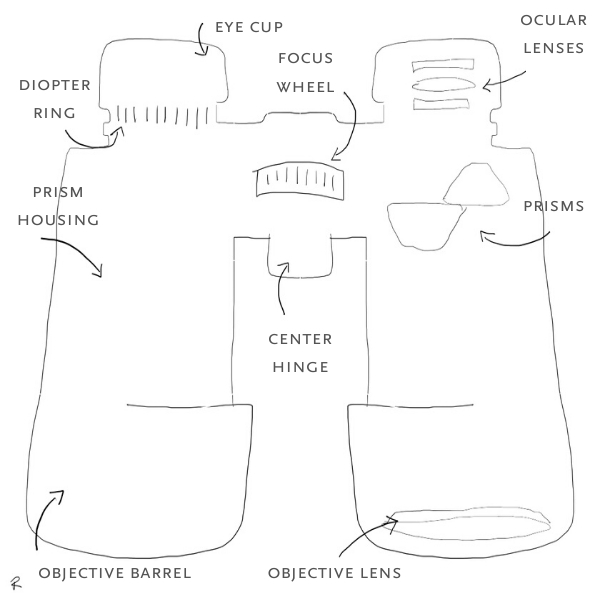Binoculars are incredible tools for naturalists and outdoor explorers. While simply holding them up to your eyes may get you close, these tips for proper binocular use will help you have sharper and more clear visuals. You'll be surprised after following our suggestions how much better you can notice the world around you!
To get the clearest images out of your binoculars, you’ll need to adjust them to your eyes. To do this, find a sign or another object that doesn’t move, and stand about 30 ft away from it. Then follow these steps:
1. Adjust the Eye Cups
Most binoculars have adjustable eye cups on each eyepiece. These eye cups should be DOWN if you wear glasses, UP if you do not.
2. Adjust the Width
Binoculars have two eyepieces connected by a center hinge. The eyepieces can move in and out to change how far apart they are. You want to set your eyepieces to match your eyes. To do this, first spread the eyepieces as far apart as they will go, then put the binoculars up to your eyes. Move the eyepieces together until you see the two circles in your view merge into one.
3. Set the Focus
All binoculars have a focus wheel, usually in the middle, which changes the focus of both eyepieces at once. You can use this wheel to focus your binoculars every time you look at a new bird.
- In addition to the focus wheel, most binoculars also have a diopter ring, which is a smaller adjustment wheel that adjusts a single eyepiece (usually the right one). Often the diopter is found on the eyepiece itself. The diopter allows you to set the binoculars for your particular eyes, and you need to set it only once.
- Turn both the diopter and the focus wheel counter-clockwise until they stop. Now, cover the right eyepiece (or the one with the diopter adjustment ring). Looking through the left eyepiece with your left eye, turn the focus wheel until the sign comes into focus. Get it as sharp as you can.
- Next, cover the left eyepiece and look at the sign using only the right eyepiece. The sign will probably be a tiny bit blurry, so turn the diopter adjustment ring until it comes into focus.
There! You’ve adjusted your binoculars for the difference between your two eyes. From now on, to focus something, you’ll only need to turn the focus wheel.
Looking at Birds with Binoculars
To find a bird, it is best to start by looking for movement with your naked eyes so you have a full field of vision. Once you see a bird that you want to look at more closely, don’t take your eyes off it. Raise the binoculars to your eyes while keeping your sight focused on the bird. This will make it much easier to find the bird through your binoculars. With the bird in view, adjust the center focus by turning it left and right until the bird is clear.
Binocular magnification
You will find that binoculars are described by a combination of two numbers: 8x50, 10x25, etc. The first number is the magnification of the object when looking through the binoculars.
The second number is the diameter in millimeters of the objective lens. Larger diameters let in more light and the image will be brighter and you’ll be able to see more detail. For birding, a magnification of 7 or 8 is ideal. The lens diameter should be between 25 and 40.
Special thanks to Jan Rising, one of our awesome Land Trust volunteer naturalists, for this post into how to use your binoculars properly!
Learn More:
- Explore common Birds of Camp Polk Meadow Preserve
- Become a Bird Surveyor for the Land Trust
- Watch this video 'Binoculars 101' by Jason Ward from Birds of North America
- The Cornell lab of Ornithology's 9 Tips for Beginning Birders
Sources:


